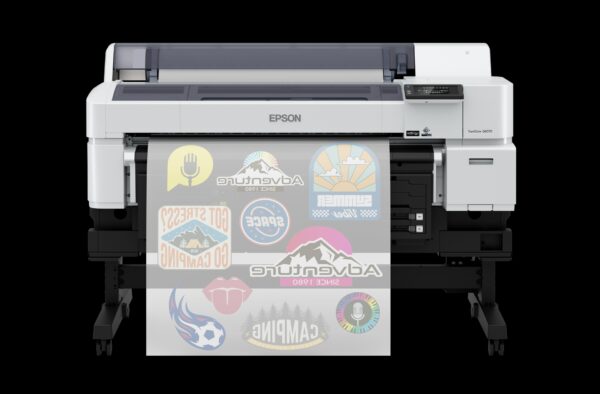Hybrid work, downsized workplaces, and fully featured products are expanding the opportunities.
Worldwide, nearly 200 trillion document pages are printed annually using powder-based toner made from granulated plastics, according to statistics compiled by market research firm I.T. Strategies. Much of that massive volume is reproduced on what is classified as A4 printers and photocopiers. Compact, A4-sized paper measures 8.27 by 11.69 inches—slightly narrower and longer than U.S letter size (8.5 by 11 inch) sheets. For decades, this format has been considered a fundamental business tool. But, as we all have seen, the office as we know it is evolving.
These days, most OEMs consider the A4 technology platform a strength in highly distributive workplaces, which have multiple employees operating in different locations. “We are seeing more mixed environments—blends of A3 and A4 technology, especially post-pandemic,” reported Elliot Williams, director of product marketing for Epson America’s Business Imaging group. With print/copy volumes continuing to decline, he acknowledged that reproductions on the larger, A3 tabloid format (loosely 11 by 17 inch) do not always make sense.
Some sites “might not need big A3s anymore,” pointed out Jose Estébanez, corporate marketing vice president for Kyocera Document Solutions America, “and A4s may be more suitable.” These customers are looking for a dealer willing to learn about their environment—how they work, and the number and size of their teams. They want a partner that can help them to optimize their print fleet.
Often, it’s an educational process, noted Estébanez. Customers and even dealers need to understand that modern-day A4 devices now have more features, better functionality, and are top quality. “Our A4s are as good as our A3s,” said Estébanez. “They have similar features, speeds, color, cost-per-click, and finishing options.”
Other OEMs concur. With more than 20 years at Lexmark International, Clark Bugg, director of North America channel sales, remembers the prevalent working landscape of the early 2000s when most office employees were contained under a single roof. “Today, we are focused on new opportunities for dealers . . . and helping our partners be more efficient.”
For most manufacturers, A4 technology enhancements represent a back-to-basics movement of sorts. Lexmark is set to introduce several new A4 products in May: namely, the C2335 for printing, scanning and/or copying (up to 35 pages per minute) and the XC2335, which adds faxing and single-pass, duplex scan capabilities.
With duty cycles of 100,000 pages and toner yields up to 20,000 for monochrome and 11,700 for color, these devices are designed for long-term reliability, according to Bugg. Wireless, Bluetooth, and low-energy consumption are standard features, and users can scan up to legal size on the flatbed. “We know dealers want enhanced serviceability,” noted Bugg, adding, “which is why they now can do more remotely: firmware updates through the cloud, remote manage and fix, etc.”
Additional high-tech features include on-board sensors and tool sets. To maximize cartridge page outputs, the printers are designed to let users know when the optimal time is to replace supplies. The new machines are highly sustainable with:
- Energy Star 3.0 certification from the U.S. Environmental Protection Agency (EPA)
- The Blue Angel eco-label (from Germany) with environmentally focused partners
- Compliance with the European Union’s RoHS (Restriction of Hazardous Substances)in Electrical and Electronic Equipment
- EPEAT (Electronic Product Environmental Assessment Tool) Silver registration
As part of its growth plan, Lexmark has consciously extended into desktop devices over the past 12 months, added Chris White, senior director of global product strategy and portfolio management. “We’ve had to ensure that there are no security gaps with these products,” he said, which is why other notable options include end-of-service wiping and data encryption.
An Industry Advantage Program also can help Lexmark’s dealer partners venture into different vertical markets, such as retail, healthcare, education, and state or local government municipalities that may require more complex, special A4 media options. For instance, labels used on outdoor shipping docks need to be weather-resistant and adjust to humidity levels. “Whether it’s a sticky, tropical climate or the dry, arid desert, our printers will adapt and adjust accordingly from a [substrate] feeding and toner diffusion standpoint,” said Bugg.
Kyocera, meanwhile, remains focused on sustainability with its line of products. “We’re proud of our energy-efficient, A4 devices that deliver a high-quality print output while reducing the user’s carbon footprint—thanks to environmentally friendly toners and big-office features in compact devices,” observed Chuck Clarke, product manager for corporate marketing. Last November, the OEM introduced a new MFP: The ECOSYS MA2100cwfx, which is designed with the all-important, aforementioned need for the flexibility to work anywhere.
Back to Basics
The vast majority of end-users today seek high-quality color output, fast speeds, and lower security risks—in that order, according to Brother International Corp. In an A4 category expansion announced last November, new color laser models deliver workforce flexibility, advanced workflow, enterprise-grade security, and low total cost of ownership (TCO) for mid-to-large-sized multiple workgroups that print/copy between 2,000 and 10,000 pages per month. “That’s our sweet spot,” said Bob Burnett, director of B2B Solutions deployment and planning for Brother USA, who noted that the OEM’s portfolio breadth supports hybrid workflows of varying end-users.
“Our engineers have developed new toner formulations and diffusing processes to ensure more vibrant, sheen color output that pops,” explained Burnett. “And, at 42 pages per minute, these devices also represent the fastest copiers ever for Brother.” The new machines also feature strong security measures, including penetration-testing (pen) validation from Buyers Lab.
The most attractive aspect for equipment dealers could be Brother’s TCO proposition, especially regarding consumables. “We now have fuser life up to 200,000 pages,” reported Burnett. “Our maximum toner capacity is up to 15,000 [copies] for black and 12,000 for color.” Additionally, belt unit life has doubled, and waste toner collection box life is three times that of Brother’s previous generation of A4 products.
With A4 technology price points ranging from $1,150 to $1,400, the Brother lineup includes eight printers: The HL-L9410CDN and MFC-L9610CDN are available to all Brother authorized partners; new Brother Workhorse Series models for all Brother Gold authorized partners, the HL‐L9430CDN, HL‐L9470CDN, MFC‐L9630CDN and MFC‐L9670CDN; and two new Brother Workhorse models for select Brother Gold partners—the HL‐EX470W and MFC‐EX670W.
Inkjet A4 Technology
Laser toner isn’t the only sustainable technology playing in this space. Last fall, in addition to the new toner laser copiers it launched, Brother also rolled out a 30-page-per-minunte inkjet printer model to the dealer channel: the MFC-J5955DW. “Inkjet is becoming more accepted into the business/office space,” observed Burnett, the manufacturer’s business-to-business expert.
Brother’s business color device offers efficient performance and reliable, high-quality output for corporate home offices and small offices. Powered by its proprietary MAXIDRIVE inkjet technology, this all-in-one machine can handle high-volume color and black-only print jobs as well as business documents up to 11×17 inches. It comes equipped with dual 250-sheet capacity paper trays for flexible paper handling and triple-layer security to help limit document and device access, and to protect against network intrusions.
Many office end-users, who may not have seriously considered inkjet in the past, are less skeptical about inkjet technology’s place these days. This change of heart is partly due to the supply chain challenges posed by the pandemic. “People bought what they could find, and Epson had product available and recovered faster,” reported Epson’s Williams. “We’ve been pleasantly surprised and believe the future is bright for A4.”
Epson refreshed its A4 portfolio early this year with improved ink chemistry and an updated user interface. In January, the OEM added the WorkForce Pro WF-C5890 color MFP, ideally suited for low- to mid-volume segments. The device is designed to address the pain points of troubleshooting and frequently replacing ink and paper, noted Williams. “It is being sold in the office and is not positioned as a consumer printer,” he stressed.
At the Ink Boldly dealer event in February, Epson disclosed plans for expanding deeper into the office print market with its heat-free, proprietary PrecisionCore inkjet technology. It also showcased a broad range of products, solutions, and marketing programs designed to help dealers grow their businesses by taking advantage of inkjet’s disruptive nature.
“Dealers obviously want solutions that work in their customers’ environments, and we are working hard to make managing supplies easier for them,” said Williams. “For some, that means a small footprint under a desk in a medical office. For others, it may mean super [ink] tanks with bottles that can print up to 50,000 pages.”
HP Inc., only a month ago (on April 1), unveiled new, eco-friendly A4 enterprise printer models to the North American market. “Flexible work arrangements are here to stay, with companies of all sizes using it as a way to attract and retain top talent,” stated Xavier Garcia, HP’s global head and general manager of office print hardware. Distributed workforce productivity is top of mind for businesses, he added.
“The Color LaserJet 4000 series is designed for small businesses to maximize productivity with easy, reliable and professional printing,” said Garcia. “As our customers grow, our Color LaserJet Enterprise 5000/6000 is ready to enable productivity and scale.”
Starting at around $1,050, the 5000/6000 printers promise to reduce energy consumption by up to 27%, HP announced at its Amplify Partner Conference in late March. This decrease is attributed to its proprietary TerraJet laser toner featured on the Color LaserJet Enterprise 5700 series and MFP 5800 series.
In addition to leaving a smaller carbon footprint, the new cartridges also allow for a 20% increase in printable colors. Plus, their plastic packaging components have been reduced by 78% and contain 35% recycled plastic content—sustainable improvements eco-conscious consumers are looking for. Last but not least, these printers are reportedly faster, too: End-users can expect a 25% increase in repro/output speeds, according to HP.
Other key features of the HP Color LaserJet Enterprise 5000/6000 and X500/X600:
- Industry-first customization with configure to order paper handling, ADF, finishing options and speed license, offering flexibility
- Designed to be a productivity and workflow hub with digital editing onto the device allowing highlighting, redacting and markups without a PC, all with the industry’s fastest A4 color laser-jet speeds
- Faster and seamless digitization using HP EveryPage with Reverse and Retry, which increases document integrity by never missing a scanned page and reducing mis-feeds with auto-recovery
- 80% of common service events completed in less than five minutes
- Highly secure printing with HP Wolf Security, which protects, detects and adapts to new threats
Dealer owners and managers are encouraged to keep an open mind when it comes to A4 laser inkjet and toner devices. These latest MFP models can help dealers to diversify into all lines of an end-user’s business, Bugg pointed out. “Beyond procurement and IT, A4 machines can penetrate into bills of lading and other front-office environments as well as produce labels for customers in specialized retail and pharmaceutical vertical markets,” said Bugg.
White, Bugg’s colleague at Lexmark, concluded: “Let’s be honest: Most end-users don’t want to think about print. It’s a necessity,” he added, emphasizing that no matter the size or type of product doing the actual printing or copying, seamless reliability and simplicity are essential.





